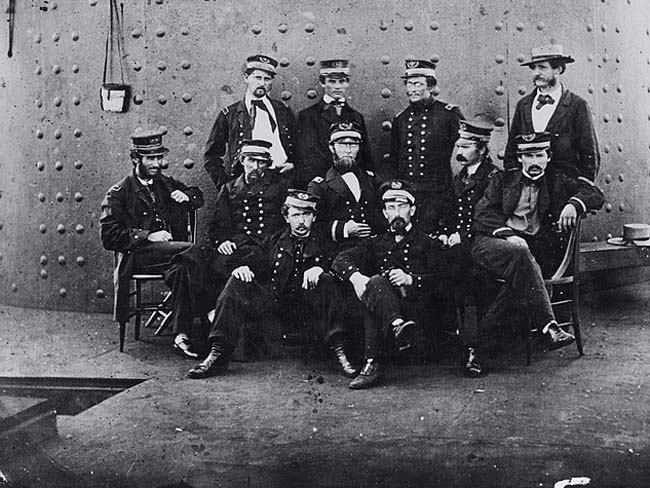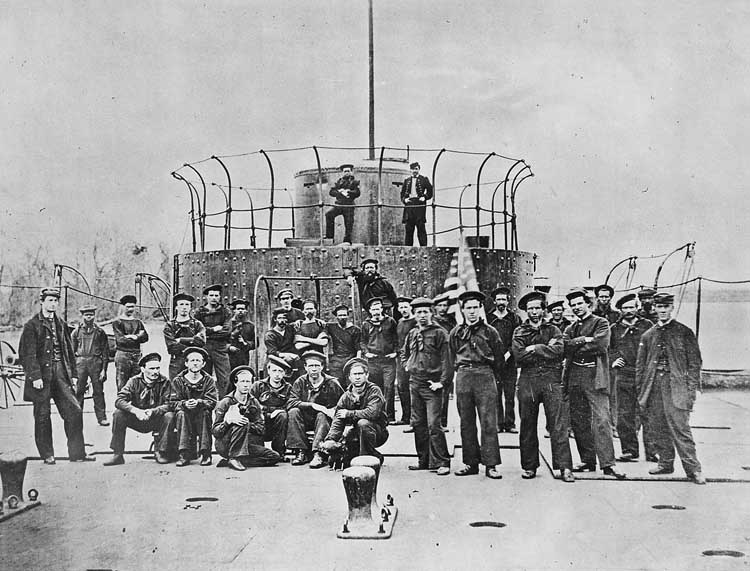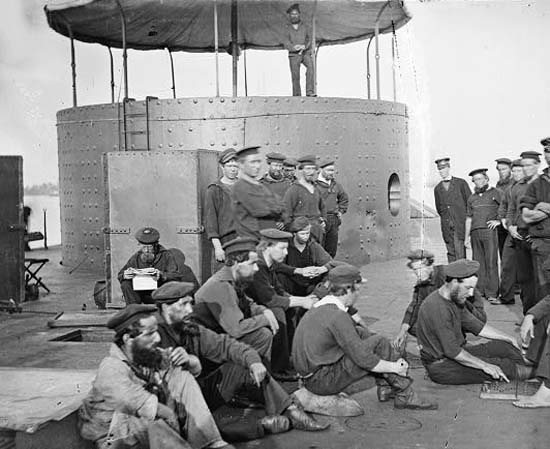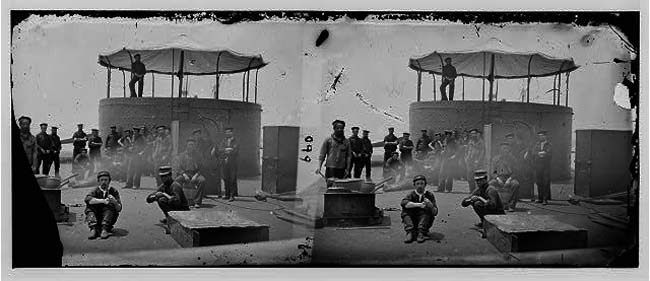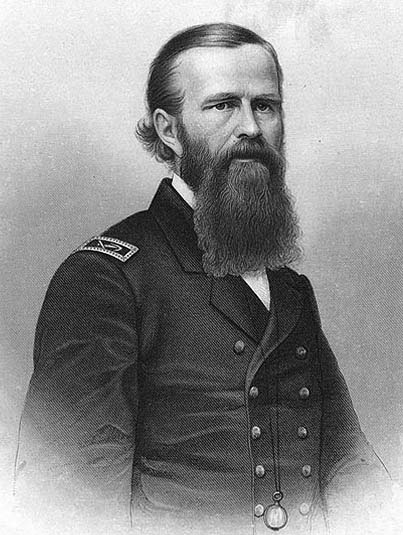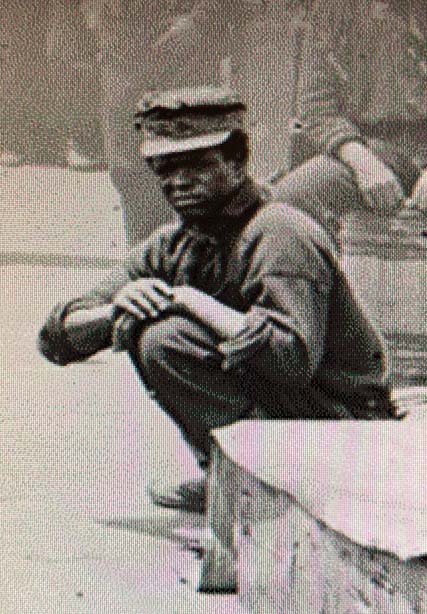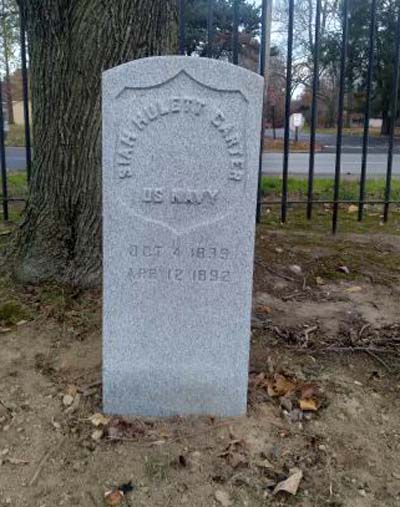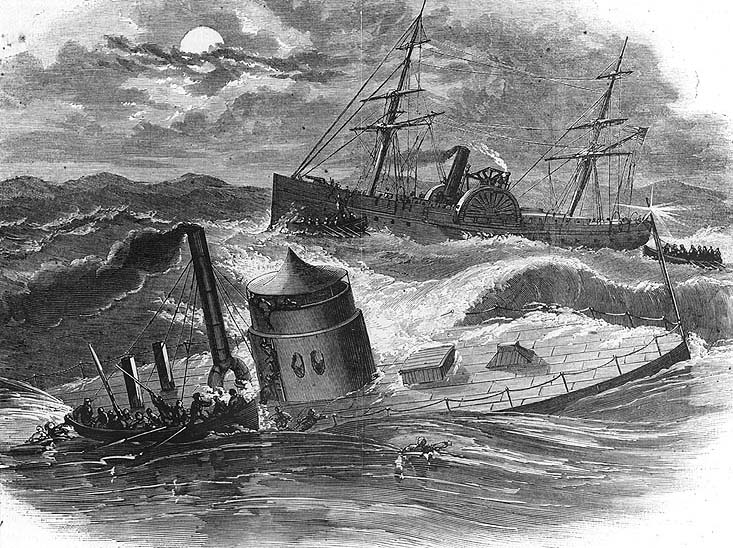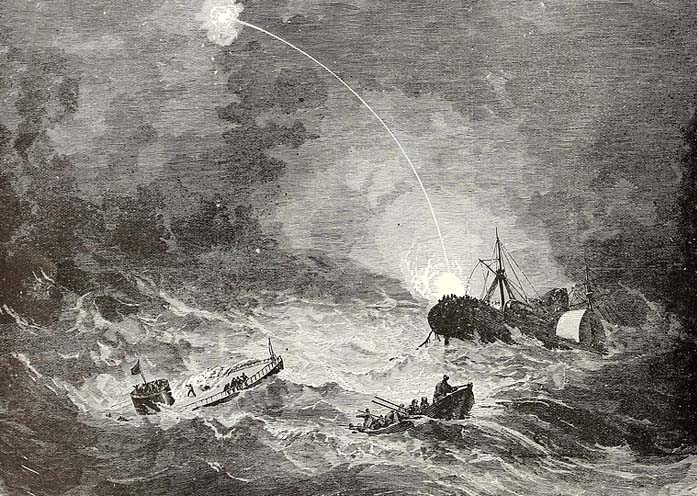1862 Deck Log of the USS Monitor
by John G M Sharp
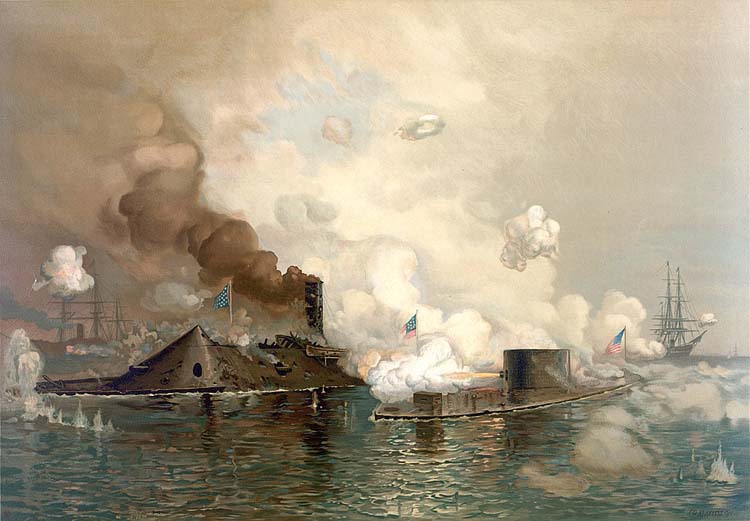
USS Monitor engaging CSS Virginia 9 March 1862
The surviving log of the USS Monitor reflects, in the terse prose of the era, the world’s first battle between ironclads. The engagement which took place on 9 March 1862 was the commencement of a revolution in naval warfare. The day prior, March 8 1862, had been had been one of the worst in the 86-year history of the U.S. Navy for the Confederate ironclad the Virginia which had sunk two ships, the USS Congress and USS Cumberland, and run the USS Minnesota aground. In total, at least 240 Union sailors had been killed. Fearing a disaster, on 6 March 1862 Secretary of the Navy, Gideon Welles, had hastily dispatched the newly built ironclad war ship USS Monitor from Brooklyn Navy Yard to Hampton Roads Virginia.1 The crew of 49 officers and enlisted men arrived in Hampton Roads after a long and exhausting journey where their vessel was buffeted by angry seas with water pouring down the smoke stack and at one point the men had to resort to hand pumps lest the ship flounder.2
1. McPherson, James M. , Battle Cry of Freedom The Civil War Era (Oxford University Press, New York, 1988), p. 376.
2. Quarstein, John V., The Monitor Boys: The Crew of the Union’s First Ironclad, (The History Press, Charleston, S.C., 2011), pp. 58-59.
On the Monitor’s maiden journey to Hampton Roads, the rough seas sicken many. Acting Assistant Surgeon, Dr. Daniel C. Logue was quickly busy treating numerous officers and crew. The ventilation systems on the new coal powered vessel were poorly designed which combined with the rolling sea made many sailors incapacitated and some dangerously ill. Among the sufferers were the Captain, Lieutenant John L.Worden, Executive Officer, Lieutenant Samuel Dana Greene, Second Assistant Engineer, Albert Campbell and Dr. Logue himself. More critical were some in the engine room crew who were "overwhelmed with hydrogen and carbonic gases. By the end of the ordeal, all eight of the engineers and eleven firemen were poisoned, having developed toxicity effects." At Dr. Logue’s direction, all the ill were taken to the top of the turret where they were laid out to catch the ocean breeze and clean air. Dr. Logue then procured some brandy (thought to be antidote for poisoning.) and made sure that each sufferer had dose.2a
2a. Laubacher, Mark,"The First Medical Man aboard the USS Monitor", Journal of Civil War Medicine, Apr-Jun 2015, Vol.,19 Issue 2, p. 60-71.
The Monitor’s primary task was to protect the USS Minnesota which had run aground the day before. On arrival, the Monitor took up a position near the grounded Minnesota and waited.
USS Monitor (1862) Officers on deck posed by her armored gun turret while the ship was in the James River, Virginia, 9 July 1862.They are Top row, left to right: Second Assistant Engineer Albert B. Campbell; Third Assistant Engineer Mark Trueman Sunstrom; Acting Assistant Paymaster William F. Keeler; and Lieutenant L. Howard Newman (Executive Officer of USS Galena). Middle Row, left to right: Acting Master Louis N. Stodder; Master's Mate George Frederickson; Acting Volunteer Lieutenant William Flye; Acting Assistant Surgeon Daniel C. Logue and Lieutenant Samuel Dana Greene. Seated on deck in front, left to right: Third Assistant Engineer Robinson W. Hands and Acting Master E.V. Gager. Library of Congress. NHHC Photograph Collection, NH 61931.As the sun rose on 9 March 1862, the CSS Virginia, with a crew of 320 officers and men. came out to complete destruction of the USS Minnesota. She was outfitted with ten guns and resembled a floating barn roof; the events of 8 March had proved her firepower was both formidable and deadly.
To their surprise they were met by the smaller, nimbler and faster Monitor. As completed, the Virginia had a turning radius of about 1 mile (1.6 km) and required 45 minutes to complete a full circle, which would later prove to be a major handicap in battle with the far more nimble Monitor. In a David and Goliath contest, the smaller Union vessel was able to outmaneuver the larger and slower Virginia. However, neither ship proved able to do any severe damage to the other despite numerous shell hits by both combatants, many fired at virtually point-blank range. In a letter to his wife, Paymaster William F. Keeler described a significant defect in the Monitor’s construction, which resulted in control problems between the officers in the pilot house and the crew loading and firing the gun on the deck below.
Below we had no idea of the position of our unseen antagonist, her mode of attack, or her distance from us, except what was made known through the orders of the captain.3
3. Mitchell, David A., Iron Coffins War Technology, and Experience Aboard the USS Monitor, (The Johns Hopkins University Press, Baltimore, 2012), p. 77.
Likewise the Virginia’s Captain Catesby ap Rodger Jones, later noted,
"the Virginia was a large target and generally so near the Monitor did not often miss. … We saw our fire made no impression on the Monitor we determined to run into her if possible, we found it a very difficult feat to do."4
4. The Civil War The Second Year told by Those Who lived It, edited by Stephen W. Sears, (The Library of America, New York, 2012), p. 118.
Monitor, unlike the Virginia, had a much lower freeboard and only its single rotating, two-cannon gun turret and forward pilothouse sitting above her deck was consequently much harder to hit with Virginia's heavy cannon. The Confederate ironclad cannon had hit the Monitor’s pilot house twice, (see photos) the turret nine times, the side armor eight times and the deck three times.5
5. Quarstein, p. 91.
The Monitor’s two guns were two smooth bore 11-inch (280 mm) guns, weighing approximately 16,000 pounds (7,300 kg) each. They could fire a 136-pound (61.7 kg) round shot or shell up to a range of 3,650 yards (3,340 m) at an elevation of +15°. The Monitor‘s unusual design made the new vessel virtually a submarine. All crew spaces and the ship's operations were located below the waterline.6
6. Quarstein, p. 4.
After fighting for hours, mostly at close range, neither vessel could overcome the other. The armor of both ships proved adequate. In part, this was because each was handicapped in her offensive capabilities. The Virginia had not expected to fight another armored vessel, so the guns supplied were only with shell rather than armor-piercing shot. Monitor's guns on the other hand were used with the standard ervice charge of only 15 lbs. (6.8 kg) of powder, which did not give the projectile sufficient momentum to penetrate her opponent's armor. Tests conducted after the battle showed that the Dahlgren guns could be operated safely and efficiently with charges of as much as 30 lbs. After hours of shell exchanges, Monitor finally retreated into shallower water after a direct shell hit to her armored pilothouse forced her away from the conflict to assess the damage. Yet neither ship did serious damage during the four hour battle.7
7. Quarstein, p. 90.
The captain of the Monitor, Lieutenant John L. Worden, had taken a direct gunpowder explosion to his face and eyes, blinding him, while looking through the pilothouse's narrow, horizontal viewing slits. Monitor remained in the shallows, but, as it was late in the day, Virginia steamed for her home port, the battle ending without a clear victor.
The captain of Virginia that day, Lieutenant Catesby ap Roger Jones, received advice from his pilots to depart over the sandbar toward Norfolk until the next day. Lieutenant Jones wanted to continue the fight, but the pilots emphasized that the Virginia had "nearly three miles to run to the bar" and that she could not remain and "take the ground on a falling tide." To prevent running aground, Lieutenant Jones reluctantly moved the ironclad back toward port.Virginia retired to the Gosport Naval Yard at Portsmouth, Virginia, and remained in drydock for repairs until April 4, 1862.
In the following month, the crew of Virginia was unsuccessful in their attempts to break the Union blockade. The blockade had been bolstered by the hastily ram-fitted paddle steamer USS Vanderbilt and SS Illinois, as well as the SS Arago and USS Minnesota, which had been repaired. Virginia made several sorties back over to Hampton Roads hoping to draw Monitor into battle. Monitor, however, was under strict orders not to re-engage; the two combatants would never battle again.
News of the epic battle set off rejoicing on both sides as each claimed victory. Paymaster Keeler wrote of the large and joyous reception,
We passed along close to Newport News. The whole army came out to see us, thousands and thousands lined the shore, covered the vessels at the docks & filled the riggings. Their cheers resembled one continuous roar.8
8. Mitchell, p .78.
The New York Times of 10 March 1862 described the battle as a "desperate naval engagement" and claimed in bold type, "Rebel Vessel Forced to Haul Off."9 While the Richmond Enquirer of 11 March 1862 trumpeted "The victory won on the waters of Hampton Roads on Saturday and Sunday last is one without parallel in the annals of naval achievement."10
9. New York Times ( New York), 10 March 1862, p. 1.
10. Richmond Enquirer (Richmond, Virginia) 11 March 1862, p. 2.
In London "The Times" on 4 April 1862 conceded to its readers that it would be "madness to trust an engagement with the little Monitor."11 The events of 9 March 1862 proved that ironclads were at an advantage over the wooden ships…because of their superior technology. They could withstand hours of battering by artillery…and due to their increased stability in the water, massive ships like the Virginia and Monitor could easily endure the recoil of their huge cannons. Another useful characteristic of the ironclads was their ability to be used in ramming missions, a maneuver used by both vessels. The hull of an ironclad ship would not be compromised by a hit associated with ramming a wooden vessel. From the moment the two ships opened fire that Sunday morning, every other navy on earth was obsolete.12
11. London Times (London, England) 4 April 1862, p. 1.
12. Williams, Tim., "Battle between the Monitor and the Virginia." http://www.ironclads.com/
Sadly, despite their newly acquired fame, unfolding events and changing fortune quickly overtook both vessels. When Union troops occupied the Norfolk Navy Yard on May 10, 1862, as the CSS Virginia was no longer an ocean-going vessel, her pilots judged her not seaworthy enough to enter the Atlantic. To prevent her capture by federal forces, on 11 May 1862 she was destroyed.
On 31 December 1862 the USS Monitor was caught in violent storm. Sixteen of her crew men perished with the vessel, see "Final Muster USS Monitor 1862.
The Monitor’s heroic battle with the Virginia quickly became the stuff of legend as it transformed naval strategy and armament worldwide. The engagement of 9 March 1862 became part of U.S. Navy curriculum and history. The Monitor's crew was well aware of the significance of what they had accomplished. Writing to Captain John L. Worden on April 24, 1862 to wish him a speedy recovery, they collectively signed themselves in bold letters, "THE MONITOR BOYS" *
Source: Green, Danna S., "In the Monitors Turret" Battles and Leader of the Civil War, volume1, edited Robert Underwood and Clarence Clough Buel, (The Century Company, New York, 1887), p. 726.
"The Monitor Boys" relaxing 1862
Transcription: This transcription was made from the logbook of the USS Monitor. Log 1862:13 I have striven to adhere as close as possible to the original in spelling, capitalization, punctuation and abbreviation.
13. USS Monitor, Log 1862, Miscellaneous Records Of The Navy Department, Roll 0047, Record Group 45, National Archives and Records Administration, Washington, D.C.
The CSS Virginia began life as the USS Merrimack. Following her capture by Confederate forces, she was rechristened the CSS Virginia and released from dry dock into the Elizabeth River on February 17, 1862. In the USS Monitor’s 1862 log; the Virginia is referred to by all the watch officers as the "Merrimac". The names of all vessels are in italics.
John G.M. Sharp
6 June 2022
James F. Gibson, stereo view "Sailors on deck of U.S.S. Monitor; cook stove at left" LOC
Photos: The accompanying photographs taken aboard the USS Monitor were made by James F. Gibson in stereo pairs. While not much is known about Gibson, he was a Scot about 1828/1829, who later immigrated to the United States possibly with noted photographer Alexander Gardner in 1856. Gibson and Gardner both sought employment with Matthew Brady and were in his employ by 1860. In the summer of 1862, Brady assigned them to photograph George McClelland’s army at Harrison’s Landing, Gibson learned of President Abraham Lincoln’s upcoming visit to the famous iron clad. Thus on 9 July 1862 he set up his camera and created the only surviving photographic images made on the Monitor. Lincoln was always fascinated by new mechanical inventions such as the Monitor, but to the disappointment of the officers and crew, the President and his staff had to depart early.
Gibson, alone or with shared credit, took approximately one hundred and fifty published Civil War photographs, the large majority being stereo views (see example above). For more on Gibson, see Thomas Waldsmith, "James F. Gibson Out from the Shadows" Stereo World, Volume 2, Number 6, February 1976, https://stereoworld.org/wp-content/uploads/2017/06/SW_V02_6.pdf
John G.M. Sharp
6 June 2022* * * * * *
Log of the U.S Steamer Monitor Lieut. J. L. Worden Commanding
26 February 1862
Comes in with fine weather
At 3 o’clock P M
Received crew from Receiving Ship North Carolina
Vessel put in commission by Capt. Almy
This day ends with clear weather3 March 1862
From midnight to 4 A.M. Weather light & clear wind from N
From 4 to 8 A.M. wind & weather the same
From 8 to Meridian, weather thick from N. E. At 10 A.M. a board of commission composed of Com Gregor, Chief Engineer Gowin, Naval Cons [Naval Constructor] Hart came on board to witness the trial trip / at 1030 A.M. Hove up the Anchor & started from Yard under full head of steam & proceeded down Harbor in Tug Boat Rapid wind N.E.1414. Edward Hartt (1825-1883) was a United States Navy constructor who oversaw or participated in the construction of many prominent ironclad and naval ships used during the American Civil War.
From Meridian to 4 P.M. at 20 minutes past first firing blank card ridges & a stand of grape with canister with full charge of [illegible 2.15] with 30% steam making 50 revolutions turned with helm hard a starboard turned in 4 min 15 sec/ within a compass of 3 times her length & proceeded toward the Yard against a strong ebbtide vessel going maximum speed of 6¼ knots an hour, greatest number of Rev[olutions] attained 64
From 4 to 6 P. M. thick rainy weather with strong N.E. Wind came to anchor of the Navy Yard with 5 fathoms water & 20 fathoms of chain.
From 6 to 8 P.M. wind & weather same at 6 P.M. put Murray in Irons .
Lawrence Murray was born in 1828 in New York City. In March 1862 Murray enlisted for a three year term. He had some prior experience as cook and there is some indication he had been to California. His first ship was the USS North Carolina where he worked as ward room steward. He was later transferred to USS Monitor on 6 March 1862. On 3 September 1862, Paymaster Frederick F. Keeler wrote to his wife Anna,
Our Wardroom Steward has been allowed liberty ashore & of course must come back drunk. His first act after getting aboard was to seize an axe and to try to split my boy’s head. The usual punishment in such cases was resorted to: he was put in double irons his hands confined behind him. In this condition he managed to get to the side & jumped overboard, being so heavily ironed of course there was no chance for him & he never rose…
The USS Monitor at that time was near Newport News, Virginia. Murray’s body was not found until 5 September 1862 when it
was finally recovered. On 6 September 1862, Keeler wrote Anna, that he and the surgeon had taken the body ashore for burial.Source: Aboard the USS Monitor 1862 The Letters of Acting Paymaster William Frederick Keeler, U.S. Navy to his Wife Anna, editor Robert W. Daily (United States Naval Institute, Annapolis, 1964), pp. 216-217.
From 8 P.M. to midnight thick rainy weather strong N.E. Wind. At 9 P.M. released wardroom steward. From 11 P.M. Norman McPhersons & John Atkins deserted taking the ship cutter & left for parts unknown & so ends the day
8 March 1862
Comes in fine weather At 3 A.M. crossed Chincoteague Shoals Gunboats astern .1515. Chincoteague Shoals lying between Assateague Island and Wallops Island Virginia is part of the inlet of the same name and its channel can be dangerous to navigation.
4 to 8 A.M. being rough, the sea was making a clean breach over the vessel At 6 A.M. made signal to boats to stand in shore further
Geo Frederickson8 to 12 A.M. fine weather & clear day 8.20 Hog Island light house S.W. At Meridian Hog Island light house N.N. W dis 6 miles Gun Boat on port stern
12 to 4 P.M. fine clear weather At 1 P.M. made Smith Island light bearing SW by W 11 miles dis[distance].
2.45 P.M. parted Hauser & bent on fresh one.
At 3 P.M. made Cape Henry light bearing S. S., heard heavy firing in distance
4 to 6 fine weather steering for Cape Henry light
Geo Frederickson6 to 8 fine clear weather running up Lyme Haven Bay at 7 P.M. took Pilot, who reported an engagement between U.S. Steamer Cumberland & Congress & Rebel Steamer Merrimac.16 & 17
16. USS Cumberland (1842-1862) served as one of the North Atlantic Blockading Squadron until 8 March 1862 when she was rammed and sunk in an engagement with the Confederate ironclad USS Virginia (formerly USS Merrimack) at Newport News, Va.
17. CSS Virginia (Merrimack), was the first steam-powered ironclad warship built by the Confederate States Navy during the first year of the American Civil War; she was constructed as a casemate ironclad using the raised and cut down original lower hull and engines of the scuttled steam frigate USS Merrimack. Virginia was one of the participants in the Battle of Hampton Roads, opposing the Union's USS Monitor in March 1862. The battle is chiefly significant in naval history as the first battle between ironclads.
At 8 P.M. Came to anchor in 10 fathoms of water, 9 P.M. got underway for Newport News to render assistance to frigate Minnesota aground. At 10 P.M. came to anchor alongside Minnesota.18
Louis Stodder18. USS Minnesota was a wooden steam frigate in the United States Navy. Launched in 1855 and commissioned eighteen months later, the ship served in east Asia for two years before being decommissioned. She was recommissioned at the outbreak of the American Civil War and returned to service as the flagship of the North Atlantic Blockading Squadron.
During the first day of the Battle of Hampton Roads on 8 March 1862, Minnesota ran aground, and the following battle badly damaged her and inflicted many casualties. On the second day of the battle, USS Monitor engaged CSS Virginia, allowing tugs to free Minnesota on the morning of 10 March. Minnesota was repaired and returned to duty, and three years later she participated in the Second Battle of Fort Fisher. Minnesota served until 1898, when she was stricken, beached and burnt to recover her metal fittings and to clear her name for a newly-ordered battleship9 March 1862
Midnight to 4 A.M.
Comes in fine weather
At ½ past one piped all to quarters, hove up the Anchor. At 2 A.M. came to anchor again
Geo Frederickson4 to 8 A.M., fine weather & calm, at – Sunrise saw 3 Steamers advancing lying under Sewell’s Point, made one out to be the Rebel Steamer Menimac [Merrimac], At 1.20 got underway & stood toward her & piped all hands to quarters,
J WebbFrom 8 to Meridian
Fine clear weather, the Rebel Steamer advancing & opened fire on the Minnesota. At 8.20 opened fire on the Merrimac, from that time until 12, constantly engaged with Merrimac
Louis StoddertFrom Meridian to 4 P M, clear weather
At 12.30 rifled shell struck the Pilot House severely injuring Commander Worden.
19 1 P.M. the Merrimac hauled off in a disabled condition, stood toward the Minnesota & received on board Asst. Sec Fox of the Navy. At 2 P.M. Capt. Worden left for Fort Monroe in charge of Surgeon Logue
Geo Frederickson19. John Lorimer Worden (1818 –1897) was a U.S. Navy officer in the American Civil War, who took part in the Battle of Hampton Roads, the first-ever engagement between ironclad steamships at Hampton Roads, Virginia, on 9 March 1862. Worden received facial wounds when a Confederate shell exploded just outside the pilot house that partially blinded him. He relinquished command to his first officer, Samuel D. Greene. He was promoted to Rear Admiral in 1873.
Acting Paymaster William Fredrick Keeler 1821-1886, to his wife Anna Dutton 9 March 1862
At this time a heavy shell struck the pilot house - I was standing near, heard the report which was unusually heavy, a flash of light & a cloud of smoke filled the house. I noticed the Captain stagger & put his hands to his eyes - "My eyes," says he, "I am blind." Blood was running from his face, which was blackened with the powder smoke.
The quartermaster at the wheel, as soon as the Captain was hurt, had turned from our antagonist & we were now some distance from her. We held a hurried consultation & "fight" was the unanimous voice of all.Lieut. Greene took the Captain's position & our bow was again pointed for the Merrimac. As we neared her she seemed inclined to haul off & after a few more guns on each side, Mr. Greene gave the order to stop firing as she was out of range & hauling off. We did not pursue as we were anxious to have more done for the Captain than could be done aboard.
Our iron hatches were slide back & we sprang out on deck which was strewn with fragments of the fight. Our foe gave us a shell as a parting fire which struck just over our heads & exploded about 100 feet beyond us.
In a few minutes we were surrounded by small steamers & boats from Newport News, the Fortress, the various men of war, all eager to learn the extent of our injuries & congratulate us on our victory.
They told us of the intense anxiety with which the conflict was witnessed by thousands of spectators from the shipping & from the shore & their astonishment was no less on learning that though we were somewhat marked we were uninjured & ready to open fire again.
The battle commenced at 1/2 past 8 A.M. & we fired the last gun 10 minutes past 12 [Meridian]
Aboard the USS Monitor 1862 The Letters of Acting Paymaster William Frederick Keeler, U.S. Navy to his Wife Anna, editor Robert W. Daily (United States Naval Institute, Annapolis, 1964), pp. 38-39.
4 to 6 P.M., fine clear weather came to anchor alongside the Minnesota
J Webb
6 to 8, fine clear weather, sharp lookout kept
Louis Stoddert
8 to 12 weather the same. 10 P.M. Lieut. Edwin Flye joined the vessel as extra officer
Geo Frederickson7 May 1862
From midnight to 4 A.M. Light breeze from W. & fine clear weather
E.V. Gager
From 4 to 6 A.M.
Moderate west wind & clear
Louis Stoddert
From Meridian to 4 P.M.
Continues with fine & pleasant weather, with gentle breeze from S.W
Geo Frederickson
From Meridian to 4 P.M.On 7 May 1862, President Lincoln paid a visit to the Monitor and Paymaster Keeler wrote his wife
The next morning as I was dressing I heard a tug come alongside & upon going on deck who should I see but Pres’t Lincoln, the Asst. Sec’y of War & Frank Blair. The Pres’t had come on board to see Capt. J. who was not yet up. (Hearing that Commodore Goldsborough was in the Dacotah near us, he wished us to send a boat for him which of course we did. The old Com. stormed & swore awfully at such a breach of etiquette but finally condescended to come on board the Monitor to see the President. (It is said that his dignity received such a shock that it has required a wet nurse ever since.20 & 20a
20. Keeler, p. 189.
20a. Broadwater, John D., USS Monitor: A Historic Ship Completes Its Final Voyage (Texas A & M University Press, Texas, 2013), p. 54.Moderate breezes from the westward and clear pleasant weather At 1 P.M. President Lincoln came on board at 1.30 the Merrimac hoved in sight made the usual preparations to receive her.
William FlyeFrom 4 .46 wind recedes Merrimac returned toward Norfolk at 4.30 A.M.
E.V. GagerFrom 6 to 8 P.M.
Light airs from West and clear
Louis StoddertFrom 8 to Midnight
Strong breeze from N.E. and Squally
Geo FredericksonMay 8 1862
Midnight to 4 A.M.
Strong wind from N.E., and clear weather
William Flye4 to 8 A.M.
Light from stern N.E. & clear weather At 5A.M. saw a small [illegible] run out from the Elizabeth River towards Newport News. At 6 A.m. the Iron Clad Galena & Gun Boat Aroostuk & Port Royal got underway and proceeded out of the river. 21 & 22
E.V. Gager21. USS Galena was a wooden-hulled broadside ironclad built for the United States Navy during the American Civil War. The ship was initially assigned to the North Atlantic Blockading Squadron and supported Union forces during the Peninsula Campaign in 1862. She was damaged during the Battle of Drewry's Bluff because her armor was too thin to prevent Confederate shots from penetrating. Widely regarded as a failure, Galena was reconstructed without most of her armor in 1863 and transferred to the West Gulf Blockading Squadron in 1864
22. USS Port Royal, a wooden, double-ended, side-wheel gunboat, was launched at New York 17 January 1862 by Thomas Stack and commissioned at New York Navy Yard, 26 April 1862.
From 8 to Meridian
Fine breeze from N.E. & clear. At Meridian got underway towards Sewell’s Point U. S, Steamer Seminole on Port beam
Louis StoddertFrom Meridian to 4 P.M.
Clear and pleasant standing in for the battery at Sewell’s Point in company with the Susquehanna, Seminole, Decotah and San Jacinto.23 At 1.10 P.M. Susquehanna opened fire, at 1.20 P.M. being about 1000 yards from Fort opened fire without receiving any reply. Continual firing slowly and effectively passed up abaft and round various obstruction’s being fired at several times the barricades in the fort were set on fire three times in the last occasion several buildings burnt Counted seven guns that worked and saw but a very small number of men. The enemy being roughly sheltered by bomb proofs firing at long intervals into the walls when fire slackened. At 2.30 ran down to the Susquehanna and reported shortly after the Merrimac made her appearance standing down. In accordance with general order dropped down The Merrimac came down to Sewell’s Point and took up our moorings
Geo Frederickson23. USS Dacotah (1859) – the only United States Navy ship to be so named – was a large (996 long tons (1,012 t)) steam sloop that served the United States Navy in the Atlantic Ocean as well as in Pacific Ocean. When the American Civil War occurred, Dacotah assumed the role of a gunboat in the Union blockade of the Confederate States of America.
From 4 to 6 P.M.
Moderate breezes from the westward and pleasant at 6 P.M, came down from Sewell’s Point and took up mooring
William FlyeFrom 6 to 8 P.M.
Light airs from S.W., and pleasant, several boats out and costal guard ship
E.V. Gager
From 8 to Midnight
Fair breezes from West and clear weather
Louis Stoddert16 May 1862
Midnight to 4 A.M.
Windy weather same swing to ebb at 4 A.M. Pickets called in at 4 A.M.
E. V. Gager4 to 6 AM
Winds N.E. and easing at 6 A.M. got underway, stood up the river the banks lined with riflemen firing at the vessels sighted the battery at 7 A.M. commenced the action Channel obstructed badly
Louis Stoddert6 to Meridian still engaged with the battery, fire from the battery very heavy their shots going through the Galena. At 11 A.M. the Galena hauled off and steamed down river, got our anchor and prepared to follow turning was struck on the turret by a 10 inch solid shot denting the view port about five inches, fired one cannon and 3-4 50 ca shells anchored at 11.45 where we started from.
Geo FredericksonMeridian to 4 P.M.
Light wind from N.E. and thick misty weather At 2 P.M. the Anntook & Port Royal got underway and proceeded down the river At 3 P.M. sent our surgeon on board the Galena. At 3.30 got underway and proceeded down the river in the company with the Galena
William Flye4 to 6 P.M.
Wind and weather the same proceeding down the river was obliged to keep below on account of riflemen on the banks firing whenever we are near
E. V. Gager
6 to 8 P.M.
Wind N.E. and back returning down the river anchored at 7 P.M. 9 miles above City Point.
Louis Stoddert8 to Midnight
Wind from S.E. to N.E. with drizzling rain.
Geo FredericksonMidnight to 4 A.M.
Wind S.E., and rainy
William Flye4 to 8 A.M.
Wind & weather rainy at 5.50 Galena made signal got underway At 6 A.M. and anchored off City Point at 7.45 A.M. we found the Gunboats Askatook & Port Royal & Nanagtuck at anchor several of our new men sick owing to the rain, made City Point made air in the ship24
E. V.Gager24. USRC Naugatuck was a twin-screw ironclad experimental steamer operated by the U.S. Revenue Cutter Service during the American Civil War. She served the U.S. Treasury Department as the USRC E.A. Stevens (later Naugatuck), a name she retained until sold in 1890. She was loaned to the Navy by the Treasury Department and thus mistakenly referred to in U.S. Navy dispatches during early 1862 as "USS Naugatuck
8 to Meriden
Wind N.E. & misty lying off City Point.
Geo Frederickson
4 to 6 P.M.
Light wind from S.E., & misty pleasant weather at 6 P.M. Port Royal and Naugatuck got underway
William Flye6 to 8 P.M.
Wind & weather same armed the watch lights seen moving along the shore.
E. V. Gager
1862 Muster Roll USS Monitor, # 53, Siah Carter, & notations on right list some of the 16 men " lost with the vessel" on 31 Dec 1862.25
25. Final Transfer and Muster Roll Crew of the USS Monitor, New York Public Library Digital Collection, https://digitalcollections.nypl.org/items/ead67ef0-a529-0130-cdef-58d385a7bbd0
8 to Midnight, cloudy & light wind from S.W., at 11 P.M. saw a boat hailing received no answer and it came along side and proved to contain contraband. [Siah H. Carter].26
Louis StoddertLeft: Josiah "Siah" Hulett Carter
Right: His tombstone in Philadelphia’s Eden Cemetery
26. Josiah "Siah" Hulett Carter was born in 1838 in Charles City, Virginia, and died 1892.
Paymaster Frederick F. Keeler USN records, that on May 16, 1862 someone shouted,
Boat Aho, this was followed by the shout, "Boarders," and the crack of a rifle. Instantly a stampede followed from below decks as the crew and officers gathered on deck to fend off the attackers. Pay Master Keeler wrote that a voice cried out from a nearby boat, "O, Lord’ Massa, oh, don’t shoot, I’se a black man Massa, I’se a black man."
With that freedom seeker Josiah "Siah" Hulett Carter pulled alongside and boarded the USS Monitor. Carter though was not necessarily free, for officially the Fugitive Slave Act was the law of the land and many seeking freedom had been denied their requests. However, Monitor’s captain brought him on board and he joined the Union Navy as a "first class boy," one of the Navy’s first enlisted "contrabands" as former slaves were called. Once aboard Carter was assigned various duties as a coal heaver, carpenter and assistant to the cook.
In late December 1862, Monitor was ordered south to support a Union attack on Wilmington, North Carolina. After waiting for the weather to clear, she left Hampton Roads under tow on December 29, 1862. The iron clad, unusual in almost every respect, was built with a hull of very low freeboard, with a large cylindrical gun turret mounted amidship and designed to present the smallest possible target to enemy gunfire. She was designed for shallow rivers and thus not seaworthy on the open ocean. On New Year’s Eve, December 31, 1862, as storm seas began to build and as she passed Cape Hatteras, the unseaworthy Monitor began shipping water from her many leaks and when water reached the fires on board all power was lost. Soon Monitor foundered and sank with a loss of 16 crew members.
Fortunately Carter was one of the survivors. He was next assigned to the three-masted store ship USS Brandywine and later to the side-wheel steamboat USS Florida where muster rolls list him as Landsman. He later wrote of his utter feeling of freedom and peace that he felt being away from the slaveholding Shirley family and working for the Union.
Carter was discharged from the Union Navy in May 1865 and returned briefly to Shirley Plantation to wed formerly enslaved Eliza Tarrow. Together the young couple had thirteen children. Carter worked as a laborer in Philadelphia, Pennsylvania, before his death in 1892.
Siah Hulett Carter was buried in Philadelphia’s Eden Cemetery.
Sources, U.S. Navy Memorial, "Siah Carter", CDR Roy A. Mosteller, USNR (Ret), http://navylog.navymemorial.org/carter-siah
See also Siah Carter Findagrave.com, https://www.findagrave.com/memorial/177015319/siah-hulett-carterADDENDUM
The Sinking of the USS Monitor 31 December 1862
The following account off the sinking of the USS Monitor was written by Paymaster William F. Keeler USN to his wife Anna. Keeler’s letter was written after the USS Rhode Island returned to port and is dated 6 January 1863. Keeler’s letter has been greatly condensed and begins when he was given the order to prepare to abandon the sinking vessel.
About this time the report was brought from the engine room that the water had reached the furnaces & the fires being extinguished. Our Commanders orders were given calmly & coolly & met with a ready and cheerful response from officers and men…After an hour that seemed an eternity to us, boats were seen approaching… Hoping to be able to get off in one of the approaching boats & to take with me the books & accounts of the vessel, I started for my stateroom to gather them up. I passed down the Turret ladder, felt my way around the guns & making a misstep fell from the top of the berth deck ladder to the deck below.
A dim lantern swinging to & fro with the motion of the vessel just served to make the nearest objects visible in the thick darkness.
The Wreck of the Iron-clad USS Monitor 31 Dec 1862I passed across this deck down into the Ward room where I found the water nearly to my waist & swishing from side to side with the roll of the ship & groped my way through the narrow passage to my state room… After groping for a little time I collected what books & papers I deemed important to save but found them an unmanageable a mass that the attempt to save them would be utterly useless & only endanger my life as my whole physical energy would be needed to get me over the wave-washed deck & into the boats.
I took down my watch which was hanging on a nail nearby & putting it into my pocket, I desisted from attempts to open the safe and started to return…
Everything was enveloped in thick murky darkness, the waves dashing violently across the deck over my head; my retreat to be made through the narrow crooked passage leading to my room where tables & chairs were surging violently from side to side. I reached the goal & found our consort [USS Rhode Island]. I expected every instant to see her thrown against our iron side & both vessels go down together.
USS Monitor sinking, 31 Dec 1862It was a scene well calculated to appall the boldest hearts. Mountains of water were rushing across our decks & foaming along our sides… Upon the order from Captain B to lead the men to the boats, I divested myself of the greater portion of my clothing to afford me greater facility for swimming in case of necessity & attempted to descend the ladder leading down the outside turret…A huge wave passed over me tearing me from my footing & bearing me along with it. I was carried as near as I could judge ten or twelve yards from the vessel’s side…I came to the surface & the backset of the wave threw me against the vessels side near one of the iron stanchions. I grasped it with all the energy of desperations and drawing myself on the deck worked my way along the life line & was hauled into a boat. We were in a leaky overloaded boat and had nearly half a mile to row before we could reach the Rhode Island.
Source: Aboard the USS Monitor 1862 The Letters of Acting Paymaster William Frederick Keeler, U.S. Navy to his Wife, Anna editor Robert W. Daily (United States Naval Institute, Annapolis, 1964), pp. 256-259. Images Naval History and Heritage Command, public domain.
* * * * * *
Paymaster William F. Keeler’s USN "Statement of the accounts of crew of U.S.S Monitor, lost Dec 31, 1862"
IMAGE 1 and IMAGE 2On 17 January 1863, Paymaster William F. Keeler wrote to Secretary of the Navy, Gideon Welles, with the requested account of the officers and crew for the fourth quarter of 1862. As paymaster, Keeler was responsible to certify and ensure USS Monitor crew members or their survivors, were paid all funds and allowances due them. Keeler took his responsibilities seriously. On the night of 31 December 1862, as the iron clad was floundering in a violent sea, aware the ship was sinking he made his way into the rapidly submerging passageways and decks as waves began to inundate the vessel pouring water down the ports and into the staterooms. Everything, he wrote, "was enveloped in thick murky darkness".
Risking his life, he searched for his office and attempted in the dark to open the ship safe and recover the payrolls and related papers. He quickly realized, with the water rapidly rising in the compartment to waist level, just how futile his journey was.After groping for a little time, I collected what books & papers I deemed important to save but found them an unmanageable a mass that the attempt to save them would be utterly useless & only endanger my life as my whole physical energy would be needed to get me over the wave-washed deck & into the boats.
After making a fast trip to Washington D.C. to review the pay records on file with the Secretary of the Navy, Keeler composed a "Statement of the accounts of crew of U.S.S Monitor, lost Dec 31, 1862". He also annotated in the remarks section the names of those who perished with the ship on 31 December 1862 as "Lost".
Officers and Crewmen, who perished on 31 Dec 1862
ATTWATER, Norman Knox, Act. Ensign
FREDERICKSON, George, Act. Ensign
HANDS, Robinson, Woolen, 2rd Asst. Eng.
LEWIS, Samuel Augee, 3rd Asst. Eng.Enlisted Crew:
ALLEN, William, Landsman, born in England, 5’& 10", 24y.o., ships #70
COOK, Robert, 1st Cl. Boy, African American, 5’& 6½"20y.o, enlisted Howard county Va., # 59
BRYAN, William, Yeoman, born in NYC, 5’& 7½" 31y.o., ships #39
EAGAN, William H., Landsman, born in Ireland, 5’& 6", 21y.o., ships #73
HOWARD, Robert H., Officer's Cook, African American, born Howard County Va.,5’ & 6½"20y.o
FENWICK, James R., Quarter Gunner, born in Scotland, 5’& 5", 23yo, ships #48
JOYCE, (Joice) Thomas, 1st Cl. Fireman, born in Ireland, 5’& 9½", 23yo, ships #35
LITTLEFIELD, George, Coal Heaver, born in Saco, ME, 5’& 7½", 25yo, ships #67
MOORE, Daniel, Landsman, African American, born Prince William County Va., #75
NICKLIS (Nickles), Jacob, Seaman, born in Buffalo (?), NY, 5’ & 7½", 21yo, ships #61
WENTZ, Wells (John Stocking), Boatswain's Mate, born in Binghamton, NY, 5'& 8", 32yo, ships #43
WILLIAMS, Robert, 1st Class Fireman, born in Wales, 5’& 8½", 30yo, ships #4Sources: For list of those who perished 31 Dec 1862 USS Monitor, U.S Marine Sanctuary NOAA https://monitor.noaa.gov/150th/welcome.html
Holloway, Anna Gibson, "Ironclad Revolution: The History, Discovery and Recovery of the USS Monitor" (2012),
Dissertations, Theses, and Masters Projects. William & Mary. Paper 1539623591
https://dx.doi.org/doi:10.21220/s2-6ta9-r518New Haven Conn
Jany 17th 1863Sir,
I have but reached this place when I found your letter & telegram in relation to the accounts of Monitor’s crew waiting for me.
I beg leave to say in reply that the Pay Rolls of the officers & crew from the time the Monitor went into commission up to the expiration of the 3rd Quarter are on file in the 4th Auditors Office.
The accounts of the 4th Quarter (which have not survived) were lost with the vessel.
I have the honor to enclose a list of the crew at the time of the loss of the vessel with their rate at the time, also the changes made in the rating of some of them during the 4th Quarter- The statement is made from memory but I believe it to be correct –
I went to Washington for the express purpose of procuring information in regards to the settlement of my accounts with the Department & supposed when I left that I had done all that was required of me – no neglect of any duty was intended – Should my presence in Washington be necessary, I will leave immediately upon the receipt of a telegram from you -
Very Respectfully Your Obedient Servant W. F. Keeler
A[Acting] Paymaster U.S.N.Addressed to:
Hon Gideon Welles
Secy of the Navy
Washington D.C.Source: Officer’s Letter to the Secretary of the Navy by officers assigned to ships, stations, and Navy bureaus, Navy Officers Letters 1802-1884, Roll 0311, pp.-1-5, National Archives and Records Administration, Washington D.C. Keeler, W.F. to Gideon Welles,17 Jan 1863
* * * * * *
"That wild night when the Monitor went down has made us to each other as brothers."
Dr. Greenville M. Weeks USNDr. Weeks was born 22 November 1837 in New York City. He was a graduate of Columbia University Medical School College of Physicians and Surgeons 1859-1860. He first volunteered with the U.S. Army and was attached to the 72nd New York Regiment, at the 1st Battle of Bull Run. He was later appointed to the U. S. Navy and served on the USS Valley City and USS Brandywine. He was assigned to the USS Monitor on 8 November 1862 and was aboard on the night of 31 Dec 1862 He survived the sinking of the vessel but his right hand was seriously injured, caught between rescue boats, his shoulder was dislocated and three fingers from his right hand were later amputated. He was promoted by President Abraham Lincoln to consulting surgeon with the rank of major, brigade surgeon and acting medical director, Department of Florida. In 1871 he resumed medical practice in civilian life. He married Pauline M. Sauer, author Resolution Recognizing Cuban Independence. Dr. Weeks died April 26 1919 at the Home for Disabled Soldiers, Kearney, New Jersey.
LETTER IMAGE
New York
January 21st 1863Sir,
When the Monitor went down, I lost everything but the few clothes I had on, and, with my other things, my commission and all my orders went down. I would therefore, as my superior officers have told me I must, apply to the Navy Department for them, trouble you copies of my first orders or commission and also of my two last orders, one ordering me to the Brandywine and the other sending me to the Monitor.
I am Sir Very Respectfully
Your Obedient ServantGreenville M. Weeks
A A Surgeon U.S.N.
Late of the USS MonitorTo Gideon Welles
Secretary of the Navy
Washington D.C.* * * * * *
LETTER IMAGE
Washington Feb
339 9 Street near 14th
Jan [no date] 63Sir,
I have the honor to report improvement in the condition of my wounds, as will enable me now to report to the Florida. The officers late of the Monitor will not be thought out of place when, Sir, you consider how the perils I shared in common with them on that wild night when the Monitor went down has made us to each other as brothers. This communication is written with my wounded fingers.
I am Sir Very Respectfully
Your Obedient ServantGreenville M. Weeks
A A Surgeon U.S.N.
Late of the USS MonitorTo Gideon Welles
Secretary of the Navy
Washington D.C.Sources: Officers Letters to the Secretary of the Navy by officers assigned to ships, stations and Navy bureaus, Navy Officers Letters 1802-1884, Volume 579, 11 Jan 1863 to 20 Jan 1863, Roll 0311, RG 45 Weeks to Welles, 21 Jan 1863.
Officers Letters to the Secretary of the Navy by officers assigned to ships, stations and Navy bureaus, Navy Officers Letters 1802-1884 Volume 570, 11 Jan 1863 to 20 Jan 1863, Roll 0312, RG 45 Weeks to Welles, Jan 1863.
* * * * * *
John "Jack" G. M. Sharp resides in Concord, California. He worked for the United States Navy for thirty years as a civilian personnel officer. Among his many assignments were positions in Berlin, Germany, where in 1989 he was in East Berlin the day the infamous wall was opened. He later served as Human Resources Officer, South West Asia (Bahrain). He returned to the United States in 2001 and was on duty at the Naval District of Washington on 9/11. He has a lifelong interest in history and has written extensively on the Washington, Norfolk, and Pensacola Navy Yards, labor history and the history of African Americans. His previous books include African Americans in Slavery and Freedom on the Washington Navy Yard 1799-1865, Morgan Hannah Press, 2011. History of the Washington Navy Yard Civilian Workforce 1799-1962, 2004.
https://www.history.navy.mil/content/dam/nhhc/browse-by-topic/heritage/washington-navy-yard/pdfs/WNY_History.pdf
and the first complete transcription of the Diary of Michael Shiner Relating to the History of the Washington Navy Yard 1813-1869, 2007/2015 online:
https://www.history.navy.mil/research/library/online-reading-room/title-list-alphabetically/d/diary-of-michael-shiner.html
His most recent work includes Register of Patients at Naval Hospital Washington DC 1814 With The Names of American Wounded From The Battle of Bladensburg 2018,
https://www.history.navy.mil/research/library/online-reading-room/title-list-alphabetically/r/register-patients-naval-hospital-washington-dc-1814.html
The last three works were all published by the Naval History and Heritage Command. John served on active duty in the United States Navy, including Viet Nam service. He received his BA and MA in History from San Francisco State University. He can be reached at sharpjg@yahoo.com
